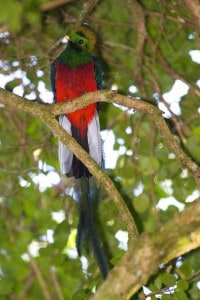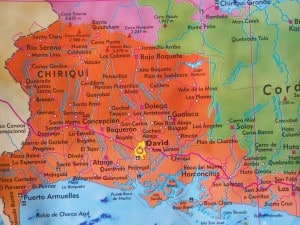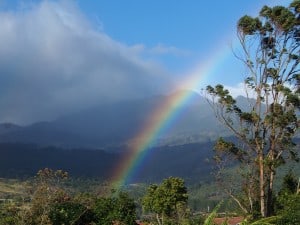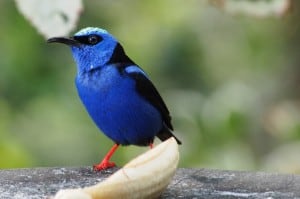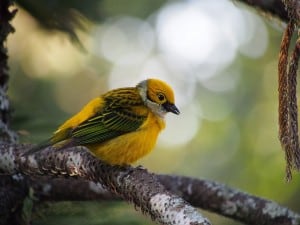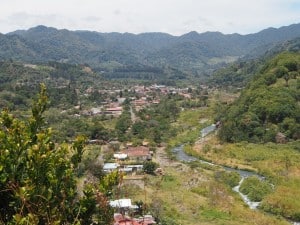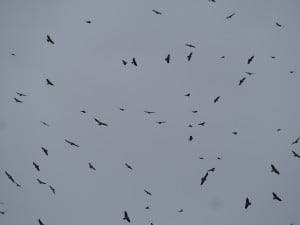We heard the quetzals before we saw them. Their resonant yelping call notes emanated from high up in the ancient trees bordering the trail. At first, I only got frustrating glimpses of the iridescent green back and throat. The small flock was moving about in the thick foliage and feeding on the fruit of wild avocados. My guide, Jason Lara, then drew my attention to a male that had hopped up onto a branch in full view. I could barely contain my excitement. The helmet-like crest, bright red belly and ridiculously long upper tail coverts sparkled in the dappled light, showing why this species is considered to be the most beautiful bird in the world. When the quetzal flew off, I could clearly see that the tail coverts are actually longer than the body itself and trail behind the bird like the train of a wedding dress. After missing these iconic birds several years earlier in Costa Rica, the sense of satisfaction was wonderful.
My wife, Michelle and I had the pleasure this past March of spending five weeks in Boquete, Panama, located in the western highlands of the country near the Costa Rica border. Straddling the land bridge between North and South America and subject to warm tropical sunlight and abundant rainfall, this tiny country boasts nearly 1000 species of birds, more than in Canada and the United States combined. This diversity owes much to Panama’s location at the intersection of two continents and two oceans. Many South American species reach their northern limit here, while species more typical of North America extend no further south. Millions of migrants, too, pass through or spend the winter in Panama.
Boquete is known throughout Panama for its cool climate, gorgeous mountain setting, and the flowers, vegetables, fruits and coffee that flourish in the rich soil. It is also home to several thousand expats from the U.S., Canada and Europe. Despite the many newcomers, it retains its original charm, largely thanks to the friendliness of the Panamanian people. For anyone who likes the outdoors, Boquete is one of Central America’s top destinations. People come from all over the world to watch birds, hike, raft, visit coffee farms and study Spanish. Michelle and I, too, spent part of our time studying the language. We took classes at the Habla Ya Spanish school, which I would highly recommend.
We heard about Boquete from Marni Craig, a former Peterborough resident who has lived in Panama for about 15 years. She put us in touch with a friend, also originally from Peterborough, whose condominium we rented. The condo was located on the mountainside above Boquete, nestled in among coffee plantations and streets lined with spectacular flowering shrubs like Brugmansia and Bougainvillea. Every morning we watched the sun climb over the heavily forested mountains and bathe the garden roses in sunlight. In the late afternoon, there were usually rainbows to admire – something else for which Boquete is famous. In fact, one of the neighborhoods above Boquete is called Arco Iris, which is Spanish for rainbow. The reason for the rainbows is the presence of “bajareque,” a mixture of wind and fine drizzle that occasionally forms over Boquete during the dry season. It doesn’t last long, however, and never interrupted our activities.
Fruit feeder
A highlight of staying at the condominium was sitting outside – a cup of exquisite Panamanian coffee in hand – and watching the multi-coloured array of birds feeding on the oranges and bananas we put out. These included outrageously coloured Red-legged Honeycreepers, blue and yellow Thick-billed Euphonias, robin-like Clay-colored Thrushes and wintering North American “snowbirds” like Rose-breasted Grosbeaks, Baltimore Orioles and Tennessee Warblers. The birds that stole the show, however, were the tanagers. About the size of Red-winged Blackbirds, tanagers form the second-largest family of birds in the world and about 12% of neotropical species. Some look like they were painted by a mad artist, bent on decorating the males in every colour combination possible. Among the species that graced our feeder were the Blue-gray, Palm, Cherrie’s, Flame-colored, Silver-throated and White-lined Tanagers. Some of the local hotels like the Boquete Garden Inn put out fruit for the birds every morning to the great pleasure of the guests eating breakfast only metres away.
The hummingbird feeder in our garden was also a source of delight. Rufous-tailed Hummingbirds were almost always coming and going. Violet Sabrewings dropped by from time to time, too. The male’s glittering violet plumage and white tail tips make it one of Panama’s most spectacular hummingbirds. A real treat, too, was the tiny Scintillant Hummingbird that came to the flowers of a small lemon tree. It is found nowhere else in the world but the highlands of western Panama and eastern Costa Rica.
Go with a guide
My full immersion into Panamanian bird life, however, was thanks to Jason Lara, a young and talented Boquete nature guide. We spent a wonderful morning on the Quetzal Trail, one of Panama’s most famous birding destinations. As we drove up to the trailhead, we stopped briefly at a roadside stand of Cecropria trees. The branches were laden with hanging tendrils of achene-type fruit (as in a strawberry) that were an irresistible magnet to birds. Over the course of 20 minutes, we watched a non-stop parade of different species flying in and out of the trees. Among them were Silver-throated Tanager, Cherrie’s Tanager, White-throated Thrush and Gray-headed Chacalaca – all of which afforded us close up views and great photo opportunities. Gray-headed Wood-rails called in the distance, while Elegant Euphonias and Scarlet-thighed Dacnises flitted about in the tall trees behind us.
Arriving at the Quetzal Trail, Jason heard the quetzals almost immediately. Like so many tropical birds, knowing the calls was key to finding them. The Resplendent Quetzal was once considered divine and associated with the “snake god”, Quetzalcoatl by Pre-Columbian civilizations. After enjoying the quetzals for at least 15 minutes, we were soon treated to a pair of duetting Prong-billed Barbets, whose loud, distinctive “cwa-cwa-cwa” call is unmistakable. The cool, wet, moss-festooned forest also offered up everything from Golden-browed Chlorophonias to Blue-throated Toucanets. The resonant “clangs” of Three-wattled Bellbirds and the ethereal fluting notes of Black-faced Solitaires were a constant presence, as well. Over the course of the morning, we saw or heard nearly 50 species, most of which were life birds for me. Jason then took me to his home to meet his family and practice my Spanish, something I’m always searching out opportunities to do.
During our stay in Boquete, Michelle and I spent many days hiking other spectacular mountainside trails just outside of town. On the Pipeline Trail, we came upon a pair of quetzals excavating a nesting hole in a dead tree. We watched the birds for at least a half-hour as wood chips flew in all directions. The most scenic walk, however, was the Three (Lost) Waterfalls trail. Although some sections are quite steep and muddy, the waterfalls are breathtaking and the views spectacular. American Dippers and Torrent Tyrannulets are a common sight on the rocks in the stream alongside the trail. Returning to the Quetzal Trail, we were treated to the amazing sight of thousands of Broad-winged and Swainson’s Hawks soaring overhead – almost like a river of birds – and making their way northward to breeding grounds in Canada.
Should you decide to visit Panama, I would recommend purchasing the “Birds of Panama” by George Angeher and Robert Dean. I also used the excellent Panama Birds – Field Guide App by Michael Mullin and Pat O’Donnell. It includes images for more than 830 species as well as songs and calls for most of them. To get a better sense of the avian delights awaiting the visitor, visit Lloyd Cripe’s site of digiscoped photos of Boquete Panama Birds at lloydcripephotos.com/ On December 10th, I’ll tell you more about Boquete and birding opportunities along the nearby Pacific Coast.
